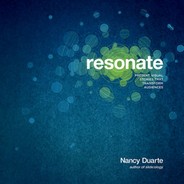44 Resonate
Notice that the end of the presentation is on a higher
plane in the presentation form than the beginning. The
ending should leave the audience with a heightened
sense of what could be and a willingness to be trans-
formed—to be able to either understand something
new or do something differently. Audience transforma-
tion is the goal of persuasion. Skillfully defining the
future reward compels the audience to get on board
with your idea.
The ending should repeat the most important points
and deliver inspirational remarks encompassing what
the world will look like when your idea is adopted.
The principle of recency states that audiences remem-
ber the last content they heard in a presentation more
vividly than the points made in the beginning or middle.
So you should create an ending that describes an
inspirational, blissful world—a world that has adopted
your idea. What will the audience members’ lives
look like? What will humanity look like? What will the
planet look like?
In order to get the most out of the audience, describe
the possible future outcomes with wonder and awe.
Show the audience that the reward will be worth their
efforts. The presentation should conclude with the
assertion that your idea is not only possible but that
it is the right—and better—choice to make.
The End
“Getting the audience to cheer, rise, and vocalize in
response to a dramatic, rousing conclusion creates
positive emotional contagion, produces a strong
emotional takeaway, and fuels the call to action by
the business leader. The ending of a great narrative
is the first thing the audience remembers.”
Peter Guber
12
Let’s say you pulled off an incredible presentation. You
used the principles in the presentation form with grace
and ease to convey your ideas, and the audience made
a commitment to transform. Sounds like a huge victory—
but it’s not over yet. The end of your presentation marks
the next phase of the adventure for the audience.
The human ability to accept new insights creates room
for people to become something different. As indicated
by the final dashed line at the end of the presentation
form, the audience starts becoming something different
from what they were at the beginning of the presentation.
But when you are done delivering your presentation, the
adoption of your idea is still inconclusive. The audience
will determine the outcome. Great presentations end with
the audience leaving full of support; bad ones don’t. The
outcome could end as a comedy or as a tragedy. If they
don’t adopt your idea, it could end as a tragedy in which
your once admirable hero makes a personal error by not
moving forward with your call to action. Or if they do
your call to action, it resolves as a comedy, which doesn’t
necessarily mean “funny”; it means there was a rise in the
fortune of a hero who deserved to succeed.
CH002.indd 44CH002.indd 44 8/16/10 9:01:16 AM8/16/10 9:01:16 AM

Lessons from Myths and Movies 45
“What we call the beginning is often the end. And
to make an end is to make a beginning. The end
is where we start from.”
T. S. Eliot
13
CH002.indd 45CH002.indd 45 8/16/10 9:01:16 AM8/16/10 9:01:16 AM
..................Content has been hidden....................
You can't read the all page of ebook, please click here login for view all page.
